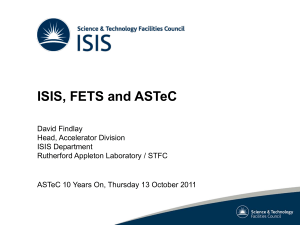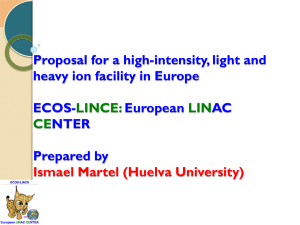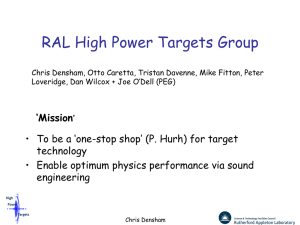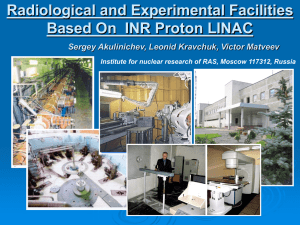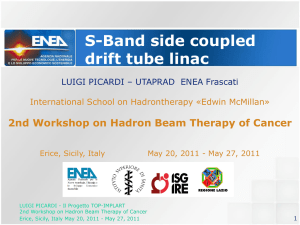isis-upgrades
advertisement
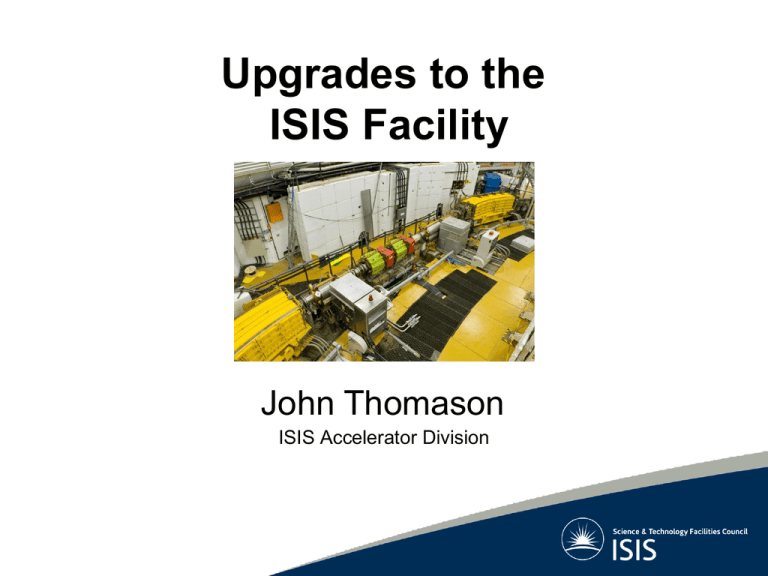
Upgrades to the ISIS Facility John Thomason ISIS Accelerator Division ISIS Accelerators • H ion source (17 kV) • 665 kV H RFQ • 70 MeV H linac • 800 MeV proton synchrotron • Extracted proton beam lines The accelerator produces a pulsed beam of 800 MeV (84% speed of light) protons at 50 Hz, average beam current is 230 A (2.9× 1013 ppp) therefore 184 kW on target (148 kW to TS-1 at 40 pps, 36 kW to TS-2 at 10 pps). ISIS Upgrades • Present operations for two target stations Operational Intensities: 220 – 230 μA (185 kW) Experimental Intensities of 31013 ppp (equiv. 240 μA) DHRF operating well: High Intensity & Low Loss Now looking at overall high intensity optimisation • Study ISIS upgrade scenarios 0) Linac and TS1 refurbishment 1) Linac upgrade leading to ~0.5 MW operations on TS1 2) ~3.3 GeV booster synchrotron: MW Target 3) 800 MeV direct injections to booster synchrotron: 2 – 5 MW Target 4) Upgrade 3) + long pulse mode option ISIS MW Upgrade Scenarios 1) Replace ISIS linac with a new ≈ 180 MeV linac (≈ 0.5MW) 2) Based on a ≈ 3.3 GeV RCS fed by bucket-to-bucket transfer from ISIS 800 MeV synchrotron (1MW, perhaps more) 3) RCS design also accommodates multi-turn charge exchange injection to facilitate a further upgrade path where the RCS is fed directly from an 800 MeV linac (2 – 5 MW) Neutrons Power / Benefit / Cost Upgraded TS1 £ + Risk TS2 Existing TS1 Power ISIS Upgrades, Developments and R&D Work • We have on-going research and studies to develop and fully exploit the machine map out the best development routes define principle upgrades undertake basic R&D into physics of high intensity beams • Main focus presently ~180 MeV Injector Upgrade summarised in the following pages holistic optimisation including targets, neutronics, … “at the user” • Next steps Exploring the possibilities for optimistic & less optimistic funding scenarios Mapping out the best options for a 1-2 MW short pulse neutron source Development and research on present machine ISIS Injection Upgrade • A New 180 MeV Injector Update old linac Increase beam power ~0.5 MW 70 MeV Linac MICE 800 MeV Synchrotron • Advantages Reduces Space Charge (factor 2.6) Qinc rp N 1 2 B TS1 2 3 Chopped, Optimised Injection & Trapping • Challenges Injection straight Activation (180 MeV) Space charge, beam stability, .... TS2 ISIS Injection Upgrade Ring Physics Study • Snapshots of the work: challenges of getting 0.5 MW in the ISIS Ring Injection Injection Straight Modelling Injection Straight Longitudinal Dynamics Simulation Results Test Distribution Analytical Work Foil temperatures Injected distributions in (x,x’),(y,y’),(,dE) Transverse & Full Cycle 3D Dynamics Predicted Space Charge Limit Single particle tune shift distributions at 0.5 MW RF Bucket Evolution of bunch Variation of key parameters Other Essentials: Activation, Diagnostics Activation vs Energy Activation Measurements Coherent Tune Shift and Resonance Electron Cloud Monitor Accelerated distributions in (x,x’),(y,y’),(,dE) Strip-line Monitor/Kicker Possible ≈ 3.3 GeV RCS Rings Bucket-to-Bucket Transfer 5SP RCS Ring Energy 0.8 – 3.2 GeV Rep Rate 50 Hz C, R/R0 367.6 m, 9/4 Gamma-T 7.2 h 9 frf sweep 6.1-7.1 MHz Peak Vrf ≈ 750 kV Peak Ksc ≈ 0.1 εl per bunch ≈ 1.5 eV s B[t] sinusoidal Grahame Rees, Ciprian Plostinar ( 800 MeV, Hˉ Linac Design Parameters ) Ion Species Output Energy Accelerating Structures Frequency Beam Current Repetition Rate Pulse Length Duty Cycle Average Beam Power Total Linac Length H800 MeV DTL/SC Elliptical Cavities 324/648 MHz 43 mA 30 Hz (Upgradeable to 50 ) 0.75 ms 2.25 % 0.5 MW 243 m Design Options Capacity upgrade scenarios • “Traditional” 3-stage MW upgrade scenario could be extended so 3.2 GeV RCS includes multiple extraction straights (or switchyard in EPB), with or without 800 MeV linac. • Stacked rings (as at CERN PSB) could be implemented as part of AC magnet replacement programme. Would require increased linac performance, but otherwise it is an engineering challenge to minimise off time during installation rather than an accelerator physics challenge, and would be a very predictable upgrade. One synchrotron with several extraction straights? Target station #1 Target station #2 “Efficient” footprint Flexible Maximises total number of neutron beam lines Easy extraction of proton beams of different energies, intensities and repetition rates to suit wide range of neutron experiments Linac Synchrotron Would need to drive trim quads. and steerers differently for different energies and intensities, but trim quads. and steerers are pulsed anyway, and so changing trim magnet current profiles from acceleration cycle to acceleration cycle should raise no fundamental complications. Target station #4 Target station #3 Ring High Intensity Beam Studies on ISIS • Some of our R&D Studies Half-integer intensity limit in proton rings Using the ISIS ring to study halo formation (Y,Y) Simulation Y profile Measurement Y profile Higher order loss effects and images Investigating complex loss mechanisms Loss vs Q measurement Model losses, benchmark on ISIS Image driven resonance Head-tail instability Key for high intensity proton rings Vertical dipole motion along bunch on successive turns Vertical difference signal (along bunch, many turns) Samples along bunch Simulation New simulation code: Set 3Di Turn Necessary Hardware R&D To realise ISIS upgrades and generic high power proton driver development, common hardware R&D will be necessary in key areas: • High power front end (FETS) • RF Systems • Stripping Foils • Diagnostics • Targets • Kickers • etc. • In the neutron factory context SNS and J-PARC are currently dealing with many of these issues during facility commissioning and we have a watching brief for all of these • Active programmes in some specific areas
